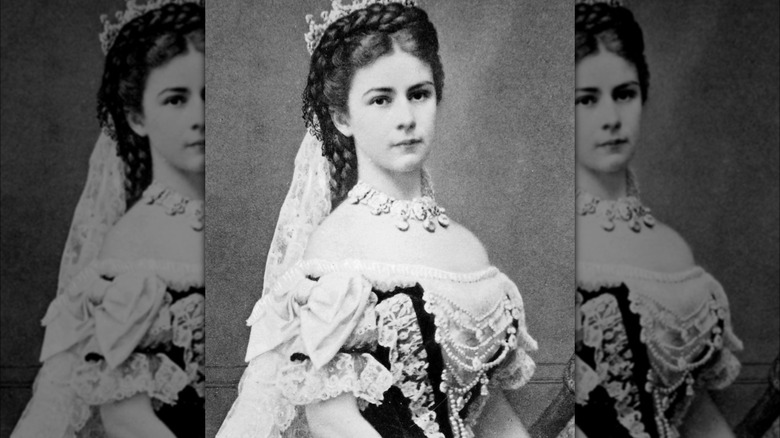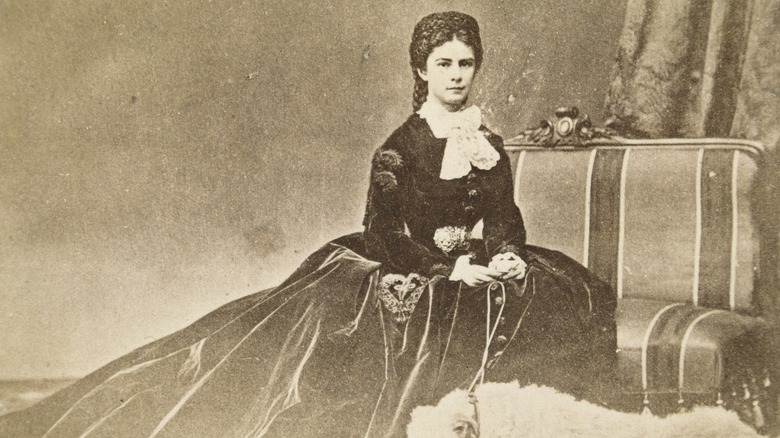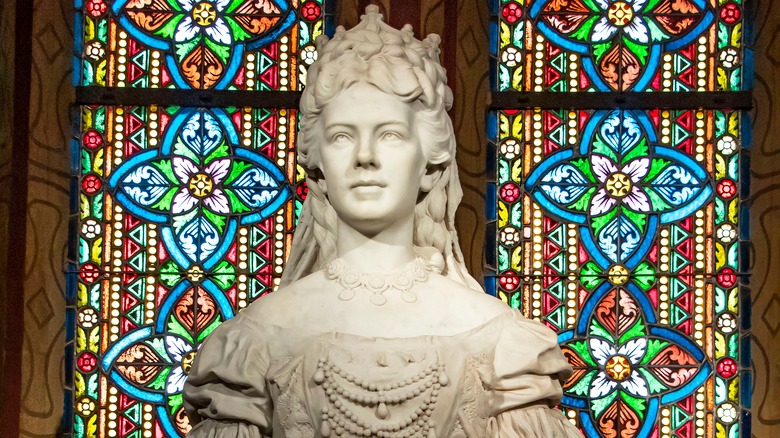The Tragic Assassination Of Empress Elisabeth Of Austria
In case anyone hasn't been paying attention to Disney cartoons over the past, say, 30-plus years, trapped princesses are a big commodity. Ariel was trapped by nobility and her own fins, Jasmine was trapped by wealth and unhappy marital prospects, Mulan was trapped by societal norms, Elsa was trapped by ice powers and the need to "let it go," and so forth. Aside from making us wonder about Disney's fixations and target audience, what if we told you we have a real-life version of such a tale? This story, however, is far more grounded and tragic, with an end not nearly as picture-perfect as that of a heroine in an animated classic.
Enter Empress Elisabeth of Austria, who ruled from 1854 to 1898 as the wife of Austro-Hungarian Emperor Franz Joseph I. "Sisi," the childhood nickname that Elisabeth commonly went by, married into the royal family at the age of only 16, as History tells us. Sisi's parents, who'd raised her in a wealthy family of seven brothers and sisters in the Bavarian mountains, had intended for Sisi's older daughter to marry the emperor. Franz Joseph I, however, was smitten by Sisi's beauty and mannerisms, and that was that.
On the day of her wedding, Sisi sat in a glass coach rolling through the streets of Vienna. A crowd of leering thousands pressed together outside the coach, hoping for a glimpse. Sisi, inside, wept. Thus commenced the tragic reign, downfall, and ultimate assassination of a publicly adored — but privately tormented — figure.
In a gilded cage, beloved
Until her assassination, Sisi not only hated life in a gilded cage but also experienced what we would now clearly define as mental health issues. As History tells us, she compared herself to a "monkey dancing at the hurdy-gurdy" for a public who zealously idolized her. She was "isolated" and "friendless" within the confines of court propriety and plagued by her husband's — the emperor's — mother, Archduchess Sophie, who once wrote (per "The Reluctant Empress"), "You cannot imagine how charming Sisi is when she cries."
In reaction to such misery, and perhaps to exert some control over her life, Sisi worked out fanatically — fencing, hiking, horseback riding, and more. Per History, she subsisted on raw milk from her own personal cow as well as oranges, eggs, and "thin broth." She spent an hour a day cinching a belt around her 19.5-inch waist and spent three hours a day caring for her renowned, ankle-length chestnut hair, which itself had the unwanted effect of garnering more public attention. Many now believe that she exhibited symptoms of anorexia nervosa, a highly self-destructive disorder characterized by a distorted body perception, abnormally low weight, and an overly restrictive diet, per the Mayo Clinic.
Come 1867, Emperor Franz Joseph I brokered a deal to incorporate the Kingdom of Hungary into his and Sisi's empire. As the queen of Hungary, Sisi gained a newfound purpose. According to History, she became greatly interested in medicine and took to visiting the sick and dying in person, going from bed to bed "like an angel of mercy," lady-in-waiting Marie Festetics recounted (via "The Reluctant Empress").
Stabbed by an Italian anarchist
Ironically, it was Sisi's charitable work, combined with lax personal security, that led to her death. When she visited hospitals, she traveled with no one but a lady-in-waiting, as History says. But after her only surviving son, Crown Prince Rudolph, died in 1889, she became a walking ghost. Her weight plummeted even more, she wandered through countries alone, got a tattoo of an anchor on her arm at age 51, and wrote (per History) that she would "travel the whole world over ... until I drown and am forgotten."
At this time in history, Sisi and Franz Joseph's empire was composed of a wide array of ethnic groups, as Brilliant Maps shows us. There were Ukrainians and Poles in the northeast, Germans and Czechs in the west, Romanians, Slovaks, Slovenes, Croats, Serbs, and even Italians in the far, far southwest in the regions of Trentino and Trieste. Come World War I, from 1914 to 1918, these areas became the battleground of Italian versus Austro-Hungarian forces, as History recounts. But the seeds of discontent were present decades earlier.
On September 10, 1898, Sisi was visiting Geneva, Switzerland, under a fake name. Word of her arrival leaked, and Italian anarchist Luigi Lucheni took his chance. He went right up to her as she was walking toward the dock to board her ship and, as Sisi thought, punched her in the chest. She boarded the ship, collapsed, and bled to death. She'd been stabbed right in the heart.


